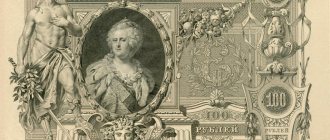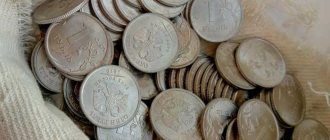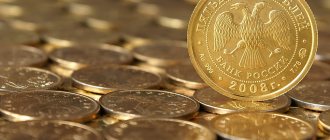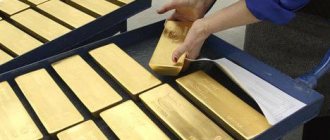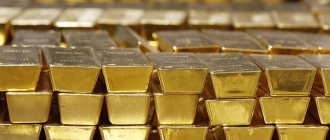In light of recent events in the world, many Russians are concerned about the security of the national currency, since the level of prices for basic goods and services depends on this. Heated debates between economists and politicians in the media do not add optimism. There are many myths circulating about how the Russian ruble is backed, and whether it needs to be backed by gold or not. Understanding why the ruble is becoming more expensive or cheaper relative to other currencies and why the dollar is still “on horseback” can only be done after careful research.
When and how did the ruble appear?
The Russian ruble appeared as a means of payment a long time ago. Back in the 13th century. But then it was more of a measure of weight than a coin. The thing is that hryvnia, which were silver ingots, were used as the national currency of Ancient Rus'. The required amount of silver was cut off, and so the ruble appeared.
It acquired the form of coins during the reign of Peter the Great, when a new, more advanced stamping apparatus was imported. The coins were printed by the Treasury. On one side the denomination was indicated, on the other - the profile of the emperor. The coins were silver.
The first paper rubles
Banknotes, that is, Russian paper rubles backed by gold and silver, appeared in the country during the time of Catherine 2. But paper money did not inspire confidence. The rulers of that time had little understanding of how to further support the ruble, given that there was not enough gold and silver. Often a situation arose when salaries were paid in banknotes, and taxes were required to be paid in silver. This led to peasant unrest and riots.
Along with paper and silver rubles, gold rubles were issued, which were used both within the country and abroad. The leadership of the Russian Empire was forced to use them when conducting international payments. The fact is that after 1860, silver fell greatly in price. New silver mines were found in America, and there was so much of it that practically nothing was given for it. And what backs the ruble, that is, silver, has depreciated.
Gold collateral and the main ways to create it
Russia's external debt is now minimal, amounting to $50,571.8 million at the end of March of this year. However, there was virtually no GDP growth in 2021, amounting to 1.469 billion US dollars. The gold and foreign exchange reserves as of March 2021 amounted to 457.8 billion US dollars, the budget deficit will be 1.6% of GDP, this will be the lowest result in recent times. All this suggests that a gold standard could be established, and could work for a fairly long period. Conditions for its successful introduction:
- strict control of the credit sector of the economy
- maintaining discipline in executing the budget
Both are quite feasible with the qualified work of the relevant structures.
If the ruble conversion rate is established, the Central Bank will be able to fully manage the liquidity of the currency; gold purchase and sale transactions will not serve as restrictions. The most acceptable way to back the ruble, according to most experts, could be coupon bonds, and the income on them can be set directly linked to gold.
A return to the gold standard will be associated with an increase in the complexity of managing the country's currency exchange rate, but this growth may become completely controllable. The main task will be to limit lending. It will be possible to regulate the conversion of rubles through the gradual withdrawal of the currency from circulation.
Soviet time
In Soviet times, the ruble was backed by gold and not only gold. What the ruble was backed by was indicated on all Soviet banknotes. And it was indicated on the banknote that it was backed by minerals, industrial enterprises and other assets of the state. Although transactions with foreign currency within the country were very limited, only citizens traveling or working abroad had the right to receive, store and exchange, the ruble was a firmly backed currency.
What can be done to secure the ruble
It is very likely that the central banks of New York and London will actively buy rubles and then present them for exchange for gold, and this could become a major threat to the success of gold backing. Therefore, new strict conversion rules will have to be established. If the gold standard is introduced, the ruble will be completely stabilized, the increase in the cost of living will decrease, and savings will begin to grow. This will also lead to important political consequences, such as reducing government spending on social security, lowering taxes, and strengthening the production base. Of course, this is all ideally and provided that all tasks are solved successfully and without distortions.
The first years after the disappearance of the USSR from the political map of the world
After the collapse of the USSR, a stable currency ceased to exist. The Russian ruble is not backed by gold or any other assets. There was a massive sale of people's property in the country, and new money was printed almost uncontrollably. Hyperinflation reigned, the refinancing rate reached a record 200%. Turning off the printing press did not stop the process of economic destruction, and in 1998 a default broke out. As a measure to prevent default, the Government carried out devaluation and redenomination, as a result of which ruble bills and coins acquired their modern appearance.
Despite all the vicissitudes of the fate of the national currency, the debate about what backs the ruble and why it is still not a world currency does not subside. Representatives of the opposition, who constantly lose elections, shout about this especially loudly. “They take gold out of the country, but they bring in unbacked green bills,” they shout, appealing to national pride.
Naturally, without access to the process of international trade, it is difficult for the average person to understand what is currently backing the Russian ruble, and why, even if it is backed with gold, it will still fall in price, and the American dollar will remain king in the international market.
Why is it so important to switch to the “gold standard” of the ruble?
So, “golden ruble” - everyone has heard this term.
But not everyone understands its meaning and how it differs from just the ruble in its modern form. Any currency is ultimately backed by the goods produced in the country (GDP) and the credibility of it. In other words, a banknote represents a credit note (obligation) of the state for a certain amount. Let's say you have a friend - let's call him Vasya - not a fool, hard-working, wealthy. And he borrows from you, providing a receipt (a bill of his own production). You know that Vasya is a reliable borrower and that his receipt can be trusted. Therefore, Vasya’s currency will be convertible, that is, his banknote can be easily used to pay with other people (it is backed by the goods Vasya produces). And even if at the moment Vasya does not have enough goods to pay off his credit obligations, you are sure that tomorrow he will still pay you off. This is a credit of trust that allows Vasily to borrow more than he can actually repay at the moment. But the goods produced by Vasily are not the most reliable means of supply, since they can deteriorate, prices for them can change depending on market conditions, moreover, Vasya can get sick and produce less of it than usual, and so on. Therefore, for reliability, Vasily creates a reserve - an untouchable warehouse of goods intended to ensure his obligations. And the best collateral stored in such a warehouse will be gold. Gold is a limited product, that is, it cannot be produced indefinitely, which determines its stable price, but it can be stored forever. And then Vasya’s receipts will become “golden”, that is, backed by a specific amount of precious metal. Here many will argue that gold, in fact, is the same commodity as all others and its price also dances depending on market conditions... Yes, this is so. But this became possible only over the last century, when world gold from a means of backing currencies turned into a common commodity, along with bread, coal, shirts and other things, and its consumption was noticeably narrowed to the needs of the jewelry and high-tech industries, where gold is used by virtue of its conductive and other properties, like a material. Until this point, gold had been the most stable collateral for financial obligations throughout the world for thousands of years. At the same time, the real value of gold has not disappeared anywhere - it still lies in the reserves of many countries of the world, BUT (!) is not a fixed guarantee for their currencies. Why?
Here we come to another common saying: “The dollar is a financial pyramid.” Many people have also heard it many times, but have not gone into detail. Why a pyramid? Why do they say that “the dollar is not backed by anything”? And why, then, does it constantly rise in price?
The fact is that gold backing a currency is a means of imparting reinforced concrete reliability and stability to money. With such stability, you are insured against inflation and can plan your finances literally decades (and even centuries) ahead. In this case, your key economic task will be to replenish your supplies at the expense of other countries, through trade, war, or other known means. In any case, we will be talking about the redistribution of a finite resource, the cost of which will only grow from year to year. This, in a certain sense, can be considered healthy competition.
But imagine that you have a way to replenish your wealth, literally, out of thin air, bypassing trade, wars and other competition, and specifically by printing wealth on a printer. And God bless him that it will constantly depreciate in value - you can print much faster than inflation and still be in profit. The American dollar is exactly like that! And the whole world knows this. And he accepts this state of affairs. How did this happen?
During the first half of the 20th century, the United States accumulated huge amounts of physical gold in its vaults. In 1933, the American government nationalized all gold within the United States - all citizens and legal entities, without exception, were ordered to hand over all private gold savings to the state treasury at a price of $20.66 per troy ounce. After which its official price was immediately raised to $35 per ounce. As a result of the Second World War, due to the collapse of the economies of European powers, countless amounts of precious metal from the gold reserves of Europe migrated to America. The USSR also paid for Lend-Lease in pure gold. American reserves during that period reached their maximum - 20,205 tons. But this was not enough for America, and then the US government made the ruined European states “an offer that they could not refuse” (c) - the so-called Bretton Woods agreement.
In mid-1944, a monetary and financial conference was held in the American city of Bretton Wood under the auspices of the United Nations, in which representatives of 44 states of the anti-Hitler coalition took part. The result of this conference was the creation of the International Monetary Fund (IMF) and the International Bank for Reconstruction and Development (IBRD). The stated purpose of creating the IMF was to expand international trade after the end of the war, and the lure that world powers bought into was to maintain the stability of the currencies of member countries by providing funds to equalize their balance of payments. At the same time, the United States offered its ruined partners a truly “magic wand” in solving their economic problems. Since the lack of gold reserves did not allow them to independently ensure the stability of their currencies, the American dollar was appointed as such a means of support, which, in turn, was backed by a gigantic gold reserve at a fixed price of $35 per troy ounce. The dollar received the status of the world reserve currency, replacing gold!
At first glance, nothing terrible has happened - instead of gold there will be a dollar, which, in turn, is backed by the same good old gold. But in reality everything turned out to be completely different. After 27 years, the United States unilaterally refused to fulfill its direct obligations as a guarantor of the Bretton Woods agreement. And over the years, something has happened that allows America today to print an unbacked dollar in any quantity.
The Bretton Woods financial system was ideal, provided that all its participants were honest with each other and none of them cheated. In fact, initially only the United States had the opportunity to cheat. And this background, in principle, was immediately visible. Therefore, the Soviet Union, which took part in the conference in 1944 under the threat of signing a separate agreement between the allied countries and Hitler and preventing Soviet troops from entering Europe, did not ratify it in 1945, when the situation changed radically. Other countries had no such choice and fell into a trap. And the USSR, which refused to ratify, received the Iron Curtain and the Cold War starting in 1946.
What has the United States done under the Bretton Woods system?
Taking advantage of its monopoly position and the virtual ban on auditing gold reserves, designed to ensure the stability of world currencies, America almost immediately began unlimited printing of dollars. The economies of all countries participating in the Bretton Woods agreement were forced to cover the subsequent dollar inflation. Thus, an “export of inflation” was created, when the security of the US Federal Reserve notes (the inscription on the dollar: “FEDERAL RESERVE NOTE”) was transferred to the entire world economy. The dollar supply grew especially strongly in the 60s, when the United States needed additional funds for the Vietnam War. And they simply printed this money (!) And the financial markets of all countries very soon felt this for themselves.
So on February 4, 1965, French President Charles de Gaulle announced his intention to exchange $1.5 billion for gold at a fixed price of $35 per ounce. If the United States refuses to fulfill its obligations, he threatened France with withdrawal from NATO and the liquidation of 189 NATO bases on the territory of his country. America was forced to exchange 700 million dollars. The rest of France's demands were denied. There were no more exchanges. This became an alarm bell, and other countries hastened to follow de Gaulle’s example and also made similar statements.
On August 15, 1971, US President Richard Nixon announced the abolition of the gold backing of the dollar. This event went down in history as the “Nixon Shock.” In March 1972, the US government devalued the dollar to $38 per ounce. A year later - up to $42.22. In 1995, a troy ounce already cost about $400. Today the price of a troy ounce of gold is more than $1,200. This is the level of dollar inflation close to reality - 3,450% over 40 years (!)
Thus, on August 15, 1971, the United States, having removed all the financial cream from the Bretton Woods Treaty, officially unilaterally withdrew from it and switched to the no longer regulated de-ure printing of its own currency. Why didn’t the dollar collapse then and continues to remain the world’s main reserve currency to this day?
Firstly, the US economy, swollen by leaps and bounds, is still the largest economy in the world. Secondly, the United States has ensured its military presence in almost all regions of the world, thanks to which it zealously supports the petro-dollar payment system. Those who even try to get out of it (Hussein, Gaddafi) will face immediate military intervention. Well, and thirdly, imagine the situation: your reserves contain dollars, valuable because they have a gold reserve behind them. And then they announce to you that now there is no security and everything that you have accumulated is empty paper. To agree with this means to ruin yourself. But, if you pretend that nothing significant happened, along with the fact that the rest of the holders of green papers will do the same, then you can preserve the conditional value of your wealth. Yes, besides: “You know that Vasya is a reliable creditor, and that his receipt can be trusted.” Well, just think, inflation will accelerate... But not right away... That’s what all holders of the dollar, as a reserve currency, did. Remember (?): “This is a credit of trust that allows Vasily to borrow more than he can actually repay at the moment.” And since then, our American “Vasily”, don’t be a fool, has continued the uncontrolled printing of receipts and today has created such a debt that he will never be able to actually repay...
If the participants in the Bretton Woods agreement in 1944 knew how things would end, they certainly would not have ratified this document. As an experienced drug addict, if he had a chance to change everything by returning to the past, he would hardly have taken his first dose, kindly provided by a drug dealer for testing, completely free of charge. But what happened happened, and today most world currencies are “hooked” on the dollar and are paying for it, forced to absorb more than half of its inflation, which is simply a means of endlessly enriching the United States at the expense of the rest of the world.
What did the USSR oppose to the Bretton Woods system?
Comrade Joseph Vissarionovich Stalin, having refused to join the Bretton Woods Treaty, began to create his own gold ruble system, which immediately brought positive results. The gold mining system in the USSR was under a strict state monopoly and all information about it was strictly classified. Thanks to the growth of the gold mining industry, the country increased its gold reserves by more than 100 tons annually. With the explosive growth rate of production in the post-war years, the ruble supply remained unchanged, which led to deflation (rise in price) of the ruble, which was followed by an annual decline in prices for consumer goods, which lasted for several more years even after the death of Stalin - an incredible situation for a modern market economy, where inflation is an indispensable condition for “economic development”. In the USSR, much earlier than in Great Britain, which suffered from the war to a much lesser extent, food cards were abolished. In 1950, the ruble was officially transferred to a permanent gold base at the rate of 4.45 rubles per 1 gram, that is, the ruble was pegged to gold. Against the backdrop of rising inflation in Western countries, the purchasing power of the gold ruble exceeded its market rate, which was adjusted from 5.30 rubles. for 1 dollar to 4 rubles. for 1 dollar. Finland and Sweden have officially expressed their desire to enter the gold ruble payment system. The system was gaining serious momentum and threatened to become a real competitor to the unsecured dollar... But the death (murder (?)) of Stalin put an end to this trend - Khrushchev, who came to power, agreed to trade for dollars, which actually erased the successes achieved and marked the beginning of the end of the independent economic development of the USSR, which, three decades later, led to the collapse of the Soviet economy, which became addicted to currency injections in conditions of total dependence of oil markets on the dollar.
And here we come to the question voiced in the title of the article: is modern Russia “threatened” by the transition to the gold ruble in the near future? Exactly so - in quotes, implying: is such a transition real and are there any prerequisites for it...
I believe that it is real and there are prerequisites - we are seeing them with our own eyes. First of all, these are political prerequisites. Russia entered into a serious confrontation with the United States against the backdrop of the Ukrainian crisis. Economic sanctions have been imposed against us. We are “the second threat to the world after Ebola.” The situation for Russia’s unfriendly step to decouple from the dollar and secure its reserves in dollars, as well as for the transition to settlements under oil and gas contracts in rubles, has never been more successful. And such a step will certainly be perceived in the United States as unfriendly. The fate of Hussein and Gaddafi in these matters is a litmus test. But the United States does not have the same opportunities to influence Iraq and Libya in relation to Russia. And those that were already involved. So Russia has no reason left to lick its wounds quietly. CRIMEA IS OURS and WILL ALWAYS BE OURS - this is only a preliminary statement of the seriousness of intentions. Putin burned bridges. He will no longer have to, like Saakashvili, look for work in America after his presidential term. The point of no return in relations with the United States has been passed and there is only one way left - forward. The only thing that Putin now has to really fear is phrases from his inner circle: “Comrade Putin is just sleeping, don’t bother him. Khrustalev, a car!
In addition, the transition to settlement of gas contracts in rubles has already begun - China, Iran, India, CIS countries... During the two ruble collapses at the beginning and end of 2014, Russia actively purchased its own securities on world stock markets. Despite the fall of the ruble in recent months, China confirmed the immutability of previously reached agreements on the ruble-yuan currency swap. Calculating, thinking a hundred times China! Why did it happen? One gets the feeling that in the Middle Kingdom they generally know more than they say. This is indirectly confirmed by the active purchase of physical gold into national reserves that began almost simultaneously in Russia, China and Kazakhstan. Of course, we are still far from the “official gold reserves” of the United States, but when switching to gold backing, it is not so much the quantity of gold that is important, but the ratio of its reserves to the money supply. And here we are clearly covering America, and we still have room for maneuver. But the overseas “Vasya” in this case will no longer be able to get away with empty promises...
What is money?
Money for market participants (with the exception of currency speculators) is not a commodity simply because it itself is worthless. They are the equivalent of a product. This is especially clearly seen in the example of non-cash payments, when money exists not in the form of pieces of paper or coins, but in a numerical, that is, abstract, form. Therefore, it is not so important in what currency the payments will be made, the main thing is that these banknotes can be used to purchase goods. So it doesn’t matter what the ruble is backed by in Russia, if a country is heavily dependent on imported goods, its currency will always sink.
Money must be recognizable and trusted. This means that all market participants accept them as a means of payment and issue goods in return. Therefore, the currency of the country that produces the most is the world currency. If 90% of countries buy American goods (even if these goods are not made in the USA), then the dollar will be valuable.
Why is gold not needed?
Neither the dollar nor the Russian ruble is backed by gold, because gold is just a metal, a mineral, albeit an expensive one. It, like any asset, is included in the backing of the national currency, but is not of decisive importance. So then what is the ruble and dollar backed by? In a modern economy, the national currency cannot be backed by only one type of product, and even one that is limited in volume. It is provided by all goods and services produced and sold abroad and within the country.
By the way, J.V. Stalin tried to buy seed grain with Soviet gold rubles - they did not accept it, they had to stamp coins with the image of the Tsar (foreigners believed in the imminent collapse of the USSR and the return of Russia to a monarchy). This suggests that gold coins were provided not so much by cost, but by other state assets. They were not so much a product as an equivalent of a product.
Critical view
Some experts view the return to the gold standard critically. The history of economics knows positive examples of such government actions, but now is a completely different time. Factors that correspond to the actual state of the economy should be taken into account.
The transition of the world's major economies to being backed by gold will be the moment of collapse of the system based on settlements in American currency.
Monetary-type inflation will create uncertainty risks for capital investments and effectively destroy savings, which are vital for financing. Some believe that currency management cannot lead to economic growth.
But the real situation is that if the countries with the largest economies in the world begin the transition to the gold standard, this will mean one thing - the end of the dollar-based currency system. Whether the ruble will be tied to physical gold or not depends on the decision of government authorities. The decision must be made taking into account the size of actual budget expenditures and the presence of long-term obligations.
Such steps by individual countries will lead to a split into two camps: some will use the gold standard, while others will not be able to do this or simply will not want to take this step.
China's policy of increasing its gold reserves and increasing production volumes could make the yuan an international currency and a competitor to the dollar.
Among those states that can do this and are systematically preparing for the introduction of the gold standard is China. The demand for gold from China in recent years has always been one of the highest; government policy is aimed at accumulating gold reserves and stimulating private investment in the metal. These measures allow the Chinese economy to protect itself from external and internal negative factors.
Chinese authorities often blame American policy for the current situation in the gold market. The US is using its huge gold reserves to suppress other currencies in order to maintain the dollar's leadership. Further strengthening of the Chinese economy may allow the internationalization of the yuan, which will become a competitor to the dollar.
Gold has historically played an important role in protecting the economic security of the state. The introduction of a gold standard, taking into account all the accompanying restrictions, can really save the country's economy in times of crises and wars.
There is another opinion regarding the introduction of the gold standard. Economists say that such a monetary system will not be sustainable, since the supply of money will be controlled not by banking institutions, but by mining companies. The price of gold will constantly change, especially depending on the discovery of new deposits of the precious metal, and inflation will be replaced by deflation.
Of course, the volume of production of the yellow metal will affect the economy, but not as dramatically as the “printing press” of the US Federal Reserve.
This development of events is possible, but has several open questions. The rate of gold production is growing much slower than the US Federal Reserve's money printing is increasing. Such actions always lead to inflation and undermine the stability of the monetary system. Under the gold standard, it is simply impossible to make money indefinitely.
Russian goods should only be sold abroad for rubles, then the people will become richer
The status of a world currency does not provide any advantages to the country that issues such currency. As long as a country sells more goods on the world market, its currency will be used as a convenient means of payment by most countries. If American goods are in demand, what is the point of using national currency as a means of payment?
The problem of the security of the Russian ruble is not that domestic goods are sold for dollars, but that the country produces little and sells little goods not only on the domestic market, but also abroad. Dependence on import supplies, and not on the dollar, is the Achilles heel of the Russian economy and the national currency. And whether the ruble is backed by gold is not so important in international trade. Even if (hypothetically) all Russian exports were sold in rubles, they would still have to be exchanged for dollars or some other currencies in order to purchase imported goods.
Trading using Russian rubles will bring nothing but additional costs for commissions on foreign exchange transactions. Moreover, you will have to prove that this is really a secured currency, and not some “African candy wrappers.” After all, most players in the foreign exchange market in the world do not even know about the existence of such a currency as the Russian ruble.
Revenue budget
Russia at that time based its policy not only on deficit-free budgets, but also on the principle of significant accumulation of gold reserves. Despite this and without the slightest increase in the tax burden, government revenues increased from 1.410 billion rubles. in 1897 grew steadily, while government expenditures remained more or less at the same level. Over the last ten years before the First World War, the excess of government revenues over expenses amounted to 2.4 billion rubles. This amount seems all the more impressive since during the reign of Nicholas II, railway tariffs were lowered and redemption payments for lands transferred to the peasants from their former landowners in 1861, as well as some taxes, were abolished.
Why did the Russian ruble sink after sanctions?
In 2014, the Russian ruble dropped by almost 2 times. The president and the government were blamed for this fall, and the reason was declared to be the annexation of Crimea and covering the costs of the Olympics in Sochi. Although these events had an impact, it was not in the way that is commonly thought.
As a result of the sanctions, Russian enterprises were denied loans from foreign banks. The consequences of the habit of living “on credit” quickly made themselves felt. Companies were forced to hold back foreign currency and buy fewer rubles.
The foreign exchange market is inert, that is, if there are no purchases of currency or the volume of purchases has fallen, the price falls. And the Russian ruble collapsed. The situation was corrected only by “draconian” methods. Since the treasury received less funds from foreign exchange earnings, the budget deficit had to be covered by additional issuance of banknotes.
The existing system in Russia of tying the ruble issue to exports (and not to the dollar, as some argue), although it gives stability to the exchange rate, is a limiting factor. Whether the ruble is backed by gold reserves or not, under the existing system of money emission, it does not matter. Although the gold and foreign exchange fund available in the country and abroad may be a good safety net, it is still better not to lead to another catastrophe so that it needs to be used.
conclusions
Is the Russian ruble backed by physical gold? No, today Russia does not have a monetary system based on the gold standard. Theoretically, such a fundamental economic decision can be made; the current geopolitical situation and the state of the gold market allow this to be done. Such measures will require strict regulation of the credit sector and a systematic policy regarding the regulation of the ruble exchange rate from the leadership of the Central Bank.
If you find an error, please select a piece of text and press Ctrl+Enter.
